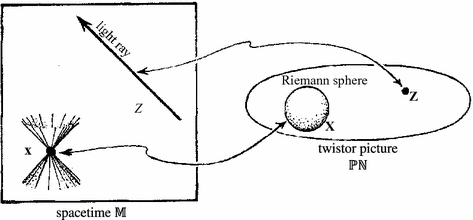Update: One more. Last night I watched a spectacularly bad Sci-Fi movie, Annihilation Earth, brought to the world by the Syfy channel. I don’t think it’s a movie that really can be spoiled for you, so here’s a plot synopsis: three supercolliders in Geneva, Orleans and Barcelona are providing power for Western Europe. Scientists who designed them realized that in a certain configuration the critics were right, and the Higgs field would get out of control and form a black hole that would destroy the earth. Evil Arab terrorists hack into one of them and reconfigure it to self-destruct. The remaining two are all that is keeping the Higgs field from expanding exponentially and causing the black hole that will annihilate everything. One of the scientists refuses to believe the other when he explains this to him, because of the color of his skin and the fact that he’s an Arab too (although he doesn’t look it). So, in the final scene he shuts down one of the remaining super-colliders and the Earth is annihilated. I guess the film-makers should be congratulated on this innovation in sci-fi film-making, ending the film with the scientists not saving the Earth but destroying it.
About
Quantum Theory, Groups and Representations
Not Even Wrong: The Book
Subscribe to Blog via Email
Join 681 other subscribersRecent Comments
- Chen-Ning (Frank) Yang 1922-2025 3
Peter Woit, liuyao, Luysii - The Situation at Columbia XXXIV 9
Peter Woit, AG, Peter Woit, Peter Woit, Peter Woit, fred [...] - The Situation at Columbia XXXIII 6
Peter Woit, MK, Guillaume Buchier, Peter Woit, lolColumbia, David Appell - Two Number Theory Items (and Woody Allen) 17
Peter Woit, Winnie Pooh, James Douglas Boyd, David Roberts, James Douglas Boyd, Timothy Chow [...] - Epistemic Collapse at the WSJ 77
Ross H McKenzie, John Baez, John Felton, Pascal, Matthew Foster, Dave Millier [...]
- Chen-Ning (Frank) Yang 1922-2025 3
Categories
- abc Conjecture (22)
- Book Reviews (123)
- BRST (13)
- Euclidean Twistor Unification (16)
- Experimental HEP News (154)
- Fake Physics (8)
- Favorite Old Posts (50)
- Film Reviews (15)
- Langlands (52)
- Multiverse Mania (163)
- Not Even Wrong: The Book (27)
- Obituaries (36)
- Quantum Mechanics (24)
- Quantum Theory: The Book (7)
- Strings 2XXX (28)
- Swampland (20)
- The Situation at Columbia (35)
- This Week's Hype (146)
- Uncategorized (1,313)
- Wormhole Publicity Stunts (15)
Archives
Links
Mathematics Weblogs
- Alex Youcis
- Alexandre Borovik
- Anton Hilado
- Cathy O'Neil
- Daniel Litt
- David Hansen
- David Mumford
- David Roberts
- Emmanuel Kowalski
- Harald Helfgott
- Jesse Johnson
- Johan deJong
- Lieven Le Bruyn
- Mathematics Without Apologies
- Noncommutative Geometry
- Persiflage
- Pieter Belmans
- Qiaochu Yuan
- Quomodocumque
- Secret Blogging Seminar
- Silicon Reckoner
- Terence Tao
- The n-Category Cafe
- Timothy Gowers
- Xena Project
Physics Weblogs
- Alexey Petrov
- AMVA4NewPhysics
- Angry Physicist
- Capitalist Imperialist Pig
- Chad Orzel
- Clifford Johnson
- Cormac O’Raifeartaigh
- Doug Natelson
- EPMG Blog
- Geoffrey Dixon
- Georg von Hippel
- Jacques Distler
- Jess Riedel
- Jim Baggott
- John Horgan
- Lubos Motl
- Mark Goodsell
- Mark Hanman
- Mateus Araujo
- Matt Strassler
- Matt von Hippel
- Matthew Buckley
- Peter Orland
- Physics World
- Resonaances
- Robert Helling
- Ross McKenzie
- Sabine Hossenfelder
- Scott Aaronson
- Sean Carroll
- Shaun Hotchkiss
- Stacy McGaugh
- Tommaso Dorigo
Some Web Pages
- Alain Connes
- Arthur Jaffe
- Barry Mazur
- Brian Conrad
- Brian Hall
- Cumrun Vafa
- Dan Freed
- Daniel Bump
- David Ben-Zvi
- David Nadler
- David Vogan
- Dennis Gaitsgory
- Eckhard Meinrenken
- Edward Frenkel
- Frank Wilczek
- Gerard ’t Hooft
- Greg Moore
- Hirosi Ooguri
- Ivan Fesenko
- Jacob Lurie
- John Baez
- José Figueroa-O'Farrill
- Klaas Landsman
- Laurent Fargues
- Laurent Lafforgue
- Nolan Wallach
- Peter Teichner
- Robert Langlands
- Vincent Lafforgue
Twitter
Videos


